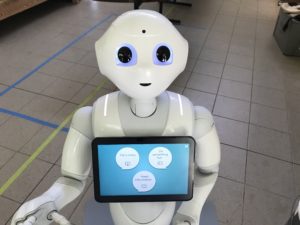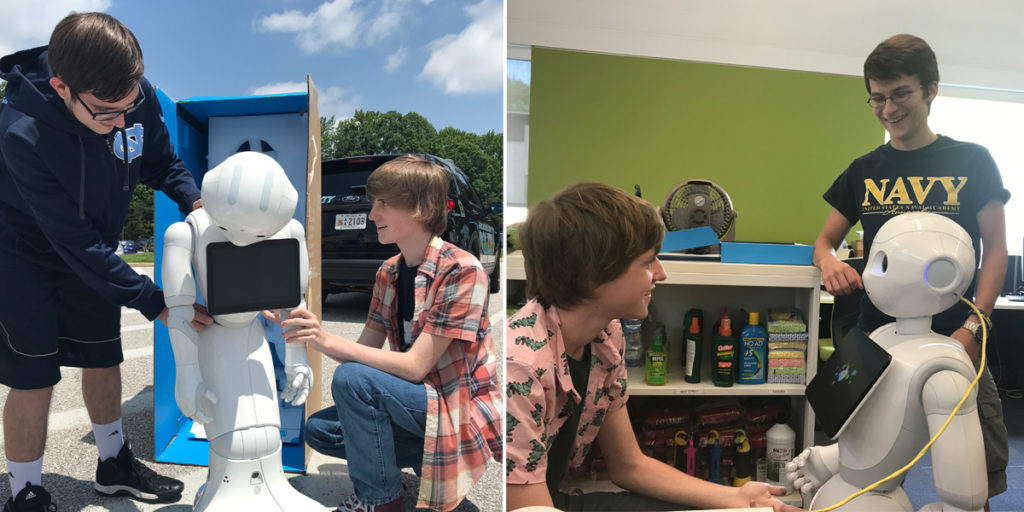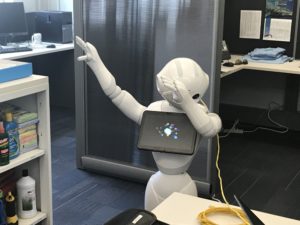by Kristen Minogue
 Don’t panic. The new robot greeting visitors at the Reed Education Center isn’t about to stage a technological coup over the SERC campus. But it can pose for selfies, tell people about SERC programs and break out a dance move or two.
Don’t panic. The new robot greeting visitors at the Reed Education Center isn’t about to stage a technological coup over the SERC campus. But it can pose for selfies, tell people about SERC programs and break out a dance move or two.
The robot goes by the name Pepper. Technically, Pepper has no gender, though most visitors—and a few staff—have taken to calling the robot “she” by default. The Smithsonian received a team of Pepper robots in February from SoftBank Robotics, to test out in their museums and other programs. Two Peppers went to the Smithsonian Environmental Research Center (SERC), where staff and students are programming them to interact with the public.
The first Pepper is on display periodically at the Reed Education Center. It can talk to visitors one-on-one, and respond to specific, preprogrammed requests, like “tell a story about SERC” or “dance freestyle.” The robot’s unfailingly wide eyes change color (blue means it’s listening, and green means it’s thinking about the right response). Sometimes, it even blinks.
“Having that little tiny detail of blinking, it makes her more human-like and more ‘alive,’” said Cosette Larash, SERC public engagement assistant who’s been programming the first Pepper.
The second Pepper spent most of the spring at the nearby South River High School, less than four miles from SERC. Alison Cawood, SERC’s citizen science coordinator, brought the second Pepper there as a way to reach students outside SERC’s usual circle. In the past, most of SERC’s work with high schools has involved environmental science students. “It’s really easy for us to engage with those students,” Cawood said. “But the students in the other pathways we haven’t really had good ways to engage.”
This year, three high school computer science students programmed the second Pepper to do more specialized actions the first Pepper couldn’t.

Left: South River High School students Zach Livesay (left) and Dan DeRycke prepare Pepper for transport from the school to SERC. Right: High school students and SERC interns Dan DeRycke and Cole Kindig program Pepper at SERC. (Credit: Kristen Minogue/SERC)
Pepper number two isn’t an identical twin of Pepper number one. The first Pepper came with a few built-in capabilities, like answering simple questions, waving at visitors to get their attention, or telling stories through slideshows on its tablet. Larash could shape those to fit SERC, but that Pepper couldn’t learn any completely new skills. Pepper number two is more of a blank slate. It has a different software, called Choregraphe, that enables the students to program gestures more specific to SERC science, such as pinching its fingers like a crab.
Of course, being high schoolers, one of their first priorities was teaching Pepper a dance move known as the dab. (For the uninitiated, this looks something like sneezing into your arm).
“The first dab was definitely a crowd pleaser,” said Dan DeRycke, a rising senior at South River High who worked on Pepper with two other rising seniors, Cole Kindig and Zach Livesay.

Pepper dabs in a SERC office (Credit: Kristen Minogue/SERC)
“Even though it’s a little outdated, it was just funny for our class to see a robot right in the center, where everyone was doing their own work,” Kindig said. “And then Pepper would say something, such as ‘Hello class,’ and then just dab. Everybody who’s a teenager, they’d find that very funny.”
As with all technology, the students ran into some glitches. DeRycke remembered a brief phase where Pepper insisted on repeating “Do you like blue crabs? Do you like blue crabs?” It’s also easier for Pepper to ask yes-or-no questions, since it only has to respond to two possible answers. Even with simple questions, Pepper needs training to respond to several possible word choices, like “restroom” and “bathroom.”
“You have to program both so it can do it,” Livesay said.
But despite the rise of automation, Pepper won’t be taking away any jobs. If anything, Pepper is creating them. After working on Pepper in the spring, both DeRycke and Kindig are continuing as SERC summer interns. And Pepper still needs a supervisor when receiving visitors at Reed.
To see what times you can visit Pepper, check out our Calendar of Events. Pepper is also on view at the Smithsonian Castle, the National Museum of African Art, the Hirshhorn Museum and Sculpture Garden, and the National Museum of African American History and Culture.
Find out when you can visit Pepper on our Calendar of Events

